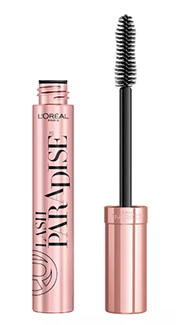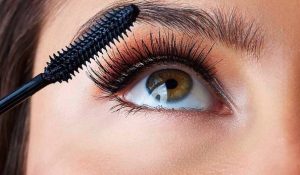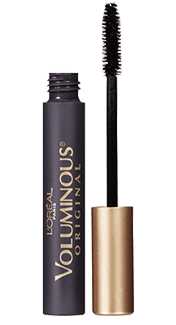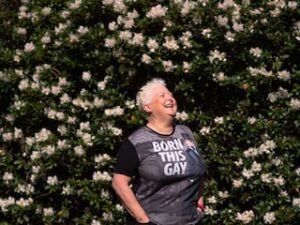By Gina Jet
I am constantly asked about mascara, possibly more than anything else, and I always respond the same way: I can’t recommend anything before I’ve asked some questions of my own.
Mascara is one of the toughest things to nail down because it comes in so many variations to satisfy various needs. It makes our lashes longer, it makes them thicker, and it makes them darker. Seems pretty straightforward, right? What you need to know is that not all mascaras are created equal. You probably already know that a lot mascaras claim to do these things, but when you get them home to try them, they fall short. Why does this happen? Did you choose a “bad” mascara, or did you just buy the wrong one for your lash type? You could also just be applying it incorrectly.
First things first: what you need to be aware of is that 90% of the mascara advertisements you see are nothing but hype. They tell you their mascara is a wondrous miracle because they want you to buy it, simple as that. Take it from someone who has an actual “mascara graveyard” (a basket full of bad mascaras that failed me), and most of them are not worth the money.
Before you spend one more dollar on a mascara that doesn’t work, start by answering these two questions: What are your lashes like, and what do you want them to be like?
It seems like an obvious question, but it really isn’t. Are your natural lashes thick or thin? Are they long or short? Are they dark or light in color? If your lashes are thin and wimpy like mine, then the answer is clear: you want a mascara that makes them thick and long and luxurious. But what if your lashes are already long? They could be long but thin, thick but short, long and thick but blonde, etc., and those are the things you need to consider before you choose an appropriate mascara.
Mascara comes in a dizzying variety of formulas. Some are “lengthening,” some are for “volume,” some claim to do both, while others boldly claim “5X volume and length.” Some have gigantic brush, some have a skinny brush, and some have a curved brush (most mascaras will have a picture of the brush on the packaging). Some are waterproof, some are “washable,” and some are black, jet-black, or carbon-black. Some have “fibers,” some are “tubes” (what the hell does that even mean?), some claim “Lash Extension,” and so on. So which one is right for you? I’ve compiled an easy guide to help you determine your lash needs first, followed by my recommendations for each:
 If your lashes are thin, you should use a volumizing/thickening mascara, such as L’Oreal Lash Paradise (also comes in waterproof) or L’Oreal Extra Volume Collagen.
If your lashes are thin, you should use a volumizing/thickening mascara, such as L’Oreal Lash Paradise (also comes in waterproof) or L’Oreal Extra Volume Collagen.
If your lashes are already thick, you should use a moderate mascara, such as L’Oreal Voluminous (also comes in waterproof) or L’Oreal Noir Balm (this one makes them soft and wispy).
If your lashes are thin and short, you should use a mascara that does both, such as *L’Oreal Double Extend (*This is a two-part product, base coat and topcoat), which is a “tubing” formula so it won’t flake or smudge.
If your lashes are blonde or light and have any of the above characteristics, follow the same recommendations. You can also choose one in brown for a more natural look.
Mascara for bottom lashes: Yes, it’s really a thing. It’s not just the formula, but also the brush. Huge mascara brushes are very difficult to use with bottom lashes, so I use Revlon Ultimate All-in-One because the brush is tiny and it works fabulously on bottom lashes!
 Mascara Primer: Otherwise known as “base coat,” this is a white substance you put on your lashes before mascara to make it go on thicker. It looks and behaves just like mascara except that it’s white. Most companies are making this now because it’s getting very popular, and that’s because it works. L’Oreal’s Lash Paradise and Voluminous are both available packaged together with this product as an optional set.
Mascara Primer: Otherwise known as “base coat,” this is a white substance you put on your lashes before mascara to make it go on thicker. It looks and behaves just like mascara except that it’s white. Most companies are making this now because it’s getting very popular, and that’s because it works. L’Oreal’s Lash Paradise and Voluminous are both available packaged together with this product as an optional set.
Other recommended brands: I love almost all L’Oreal mascaras, as you may have noticed, but I love Revlon’s mascaras too. Maybelline’s Great Lash is good if you’re patient with layering it, since it has a small brush and requires multiple coats. If you like the high-end stuff, MAC, Dior, and Too-Faced: Better Than Sex are also fantastic.
Waterproof vs. “Washable”: This is another thing that might seem obvious but really isn’t. Of course you’re going to need a waterproof mascara if you plan on being in or near water. If you’re going to a pool party and plan on swimming, or will be at risk of being splashed, then yes. Waterproof all the way. Going to a wedding and know you will cry? Yup, waterproof. Is it summer or just really hot where you live and you sweat a lot? Yeah, probably should use the waterproof formula. So why not just wear waterproof mascara all the time, you ask? Well, waterproof formulas have their disadvantages, too. Apart from being an absolute bitch to remove, it can also be stiff or “gummy” and tends to look too “heavy.” I’m not crazy about it myself but I have to use it on clients that are going to be exposed to any of the above factors, or are oily-skinned, fuss with their eyes a lot, or have a history of smudging their mascara. A popular misconception about waterproof mascara is that it’s damaging to your eyelashes. This is not true! What is damaging to your eyelashes is the method by which it is removed. Regular makeup removers are not very effective in removing waterproof mascara, even if they claim to be. Unless you buy a specific-to-waterproof mascara remover, chances are you’re going to rub and scrub your lashes to the point of redness, soreness, and even lash-loss.
 Makeup remover wipes are also ineffective in removing this stubborn product, even if they claim otherwise. I will always stand by my assertion that the fastest and most effective way to remove stubborn waterproof mascara is oil. Any kind of oil will do, but coconut oil or baby oil are my chosen oils to do the job quickly and without damage. You can apply these oils with your fingers, wadded up tissue, cotton ball, or Q-Tip. The key is to allow the oil to fully saturate the lashes and to give the oil time to do its job. Apply the oil to the lashes, above and underneath, and massage very gently into all the lashes until they are soft and “gooey.” Now you can simply wipe the mess away with a soft tissue, baby wipe, or washcloth. Then you can remove the rest of your makeup with the same kind of oil all over the face, removing the whole mess with a soft cloth. Voila! Follow up with a hot-as-you-can-stand washcloth to remove any remaining traces of makeup and oil from your pores.
Makeup remover wipes are also ineffective in removing this stubborn product, even if they claim otherwise. I will always stand by my assertion that the fastest and most effective way to remove stubborn waterproof mascara is oil. Any kind of oil will do, but coconut oil or baby oil are my chosen oils to do the job quickly and without damage. You can apply these oils with your fingers, wadded up tissue, cotton ball, or Q-Tip. The key is to allow the oil to fully saturate the lashes and to give the oil time to do its job. Apply the oil to the lashes, above and underneath, and massage very gently into all the lashes until they are soft and “gooey.” Now you can simply wipe the mess away with a soft tissue, baby wipe, or washcloth. Then you can remove the rest of your makeup with the same kind of oil all over the face, removing the whole mess with a soft cloth. Voila! Follow up with a hot-as-you-can-stand washcloth to remove any remaining traces of makeup and oil from your pores.
“Washable” mascara: This just means “regular” or non-waterproof mascara and is much easier to remove. This does not mean that it’ll come off or smudge easily, it only means that it’s easier to remove than waterproof. Regular or “washable” mascara is still pretty durable and will not smudge unless you rub your eyes, sweat profusely, cry, or get splashed by something wet right in the eyes. If you don’t plan on any of these things happening then you should be safe. You should still use oil to remove it since plain water will break it down but will not take it off your raccoon-looking face afterwards.
“Fiber” mascara: These contain very tiny fibers to bulk up thin lashes quickly. The tiny fibers attach to your lashes adding significant volume and length. Why don’t all mascaras contain these fibers? Because not everybody likes the fibers since they tend to flake and get into the eyes more than regular mascara. The other thing I don’t love about these formulas is that they seem to dry out faster. I do not enjoy spending $15 on a mascara that I will only use a handful of times before it goes to the “graveyard.”
 “Tubing” mascara: what the hell is it? This mascara is pretty cool, actually. It works by forming a “tube” around each lash that will not smudge or flake. It doesn’t melt off with moisture or heat, but instead comes off in little tubes. Think of it as a “sheath” around your lash that comes off in one piece. Instead of a messy, smudgy mess when being removed, you’ll see little “sticks” on your tissue or washcloth. This mascara can be removed with warm water that swells and weakens the tubes and just slides right off in pieces. The reason this can be a real advantage is because if or when you are unexpectedly splashed or made to cry, you will not look like Alice Cooper. I love this stuff but the one thing I don’t love about it is that it takes longer to dry upon application, so be prepared to wait a few extra minutes before continuing with the rest of your makeup process, being very careful not to touch or smudge it while you’re waiting. It’s worth the extra effort!
“Tubing” mascara: what the hell is it? This mascara is pretty cool, actually. It works by forming a “tube” around each lash that will not smudge or flake. It doesn’t melt off with moisture or heat, but instead comes off in little tubes. Think of it as a “sheath” around your lash that comes off in one piece. Instead of a messy, smudgy mess when being removed, you’ll see little “sticks” on your tissue or washcloth. This mascara can be removed with warm water that swells and weakens the tubes and just slides right off in pieces. The reason this can be a real advantage is because if or when you are unexpectedly splashed or made to cry, you will not look like Alice Cooper. I love this stuff but the one thing I don’t love about it is that it takes longer to dry upon application, so be prepared to wait a few extra minutes before continuing with the rest of your makeup process, being very careful not to touch or smudge it while you’re waiting. It’s worth the extra effort!
“Telescopic” mascara: I probably haven’t tried enough of these mascaras to see a significant difference in behavior. I’ve tried a couple of them that looked and felt like normal mascara. I tend to think of these catch words as marketing ploys until I am proven wrong, and the ones I’ve tried did not prove me wrong. If you’ve tried a telescopic mascara that’s the bee’s knees, I hope you’ll let me know.
Applying mascara correctly: Whoever tells you that there are no rules in makeup probably didn’t factor in mascara. While I’m a firm believer in doing whatever makes you happy, there are some guidelines that, when not followed, can be disastrous. Mascara is one of those things. Just like liquid eyeliner, mascara is something that must be done carefully and thoughtfully. Below are some things that you may or may not know about mascara:
Don’t be in a rush: Please take your time with this step. Use a bright, direct-facing light and a good close-up mirror. It also helps tremendously to be seated comfortably during the process. Bending forward in front of your bathroom sink with harsh overhead lighting will not help you do a good job. Relax. When applying mascara to your bottom lashes, always keep your chin down. When applying to top lashes, always keep your chin up and brows raised.
Mascara needs to be “layered.” Have you ever gotten a brand-new mascara and eagerly applied it just to be immediately disappointed? Does nothing seem to be happening when you put it on? You might not know that you need to apply mascara in layers, or “coats.” Apply one coat on the bottom lashes of one eye, then the other eye. Let both sets of bottom lashes dry for 30 seconds before applying a second coat on each. Continue like this until they look like you want them to look.
After the bottom lashes are fully dry, you can begin applying to the top lashes. Apply a single coat to the top lashes of one eye, and then go to the other eye. Wait for both sides to dry for 30 seconds before applying a second coat. Apply as many layers as you need to make them long and thick, or until they look like you want them to look. Just remember to let them dry before attempting another coat, because mascara cannot be built up when it’s wet.
Always apply mascara to the bottom lashes first: The reason for this is simple. If you do the top lashes first, and then look down to apply to the bottom lashes, the still-wet mascara on top will transfer to the eyelids and leave black specs that you will have to clean up, damaging your eyeshadow.
Yes, you still need mascara if you wear falsies: There are two reasons for this, and one reason is color. Unless your natural lashes exactly match the color of the falsies, they will be in very visible contrast to the falsies. It’s also much easier to apply mascara to your natural lashes before you glue on the falsies since doing it afterwards will likely pull the falsies right back off. The second reason is adhesion. Mascara is somewhat tacky on its own, so it will add more surface area for the falsies to adhere to. Just squeeze them all together after your glue has fully dried and you’ll have a much stronger bond. Happy plumping!
For a more comprehensive guide to mascara and false lashes, check out my e-book here.
Related
Category: Makeup







